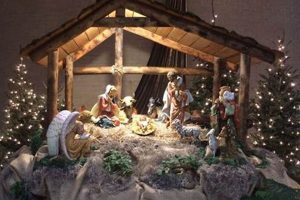Decorative boards handcrafted during the holiday season serve as festive announcements or artistic expressions. For example, a wooden plank painted with a cheerful greeting and adorned with seasonal greenery enhances a porch. These projects often involve reclaimed materials, stencils, and paint, showcasing individual creativity and seasonal spirit.
The practice of creating personalized holiday decor provides both economic and aesthetic advantages. These handmade items offer a budget-friendly alternative to commercial decorations and allow for customization to suit specific interior design preferences. Historically, crafting decorations at home has been a central part of many holiday traditions, fostering a sense of community and shared creativity.
The subsequent sections will delve into specific material choices, design strategies, and step-by-step instructions for producing unique holiday-themed signage. Furthermore, consideration will be given to techniques for aging the wood, creating stencils, and applying finishing touches to achieve a professional-looking result.
Crafting Effective Holiday Signage
Constructing appealing and durable holiday-themed boards requires careful planning and execution. The following recommendations aim to guide the process, ensuring a high-quality finished product.
Tip 1: Material Selection: Choose wood types suited for both indoor and outdoor environments. Cedar and redwood exhibit natural resistance to moisture and decay, making them optimal for exterior displays. Pine serves as an economical alternative for interior use, but requires proper sealing to prevent warping or damage.
Tip 2: Design Planning: Sketch the design before commencing construction. Consider the overall aesthetic, font styles, and the spatial arrangement of text and graphics. Proportionality and readability are critical for effective communication. For example, balance ornate fonts with simpler backgrounds for optimal contrast.
Tip 3: Precision Cutting and Assembly: Utilize accurate measuring tools and cutting techniques to ensure structural integrity. Mitered corners, secured with wood glue and fasteners, provide a polished and professional appearance. Clamps should be employed during the drying process to maintain alignment and prevent shifting.
Tip 4: Appropriate Finishing Techniques: Apply primer before painting to enhance adhesion and durability. Multiple thin coats of paint, rather than a single thick coat, yield a smoother and more uniform finish. Consider using weather-resistant paints and sealants for outdoor signs to protect against the elements.
Tip 5: Stencil Application: Employ high-quality stencils designed for crisp, clean lines. Secure the stencil firmly to the wood surface with repositionable adhesive to prevent paint bleeding. Apply paint sparingly with a stencil brush or sponge, using a stippling motion to minimize the risk of smudging.
Tip 6: Incorporate Lighting Strategically: Integrating LED lights can significantly enhance the visibility and appeal, especially during evening hours. Battery-operated string lights or strategically placed spotlights can illuminate the message, creating a warm and inviting ambiance. Ensure all electrical components are rated for outdoor use if applicable.
These guidelines emphasize the importance of planning, precision, and material selection in producing effective signage. Adherence to these recommendations contributes to the creation of aesthetically pleasing and long-lasting holiday decor.
The subsequent sections will address specific design styles and explore advanced techniques for achieving personalized and professional-quality results.
1. Material Durability
The longevity and visual appeal of festive announcements are directly contingent upon the inherent durability of the selected materials. Inferior materials quickly degrade under seasonal weather conditions, diminishing the aesthetic impact and necessitating frequent replacement. For instance, using untreated pine for an outdoor sign renders it susceptible to moisture damage, leading to warping, cracking, and paint peeling within a single season. Conversely, employing naturally weather-resistant woods, such as cedar or redwood, or pressure-treated lumber, significantly extends the lifespan of the decorative item. This choice translates into reduced maintenance costs and a sustained festive presentation over multiple years.
Material selection extends beyond the wood itself and encompasses the fasteners, paints, and protective coatings employed. Stainless steel or coated fasteners prevent rust and maintain structural integrity, even under prolonged exposure to rain or snow. Exterior-grade paints, formulated with UV inhibitors and mildew-resistant additives, resist fading and fungal growth, preserving the vibrancy of the painted design. The application of a durable clear coat or sealant further enhances protection against the elements, creating a barrier against moisture intrusion and abrasion. A case in point is applying marine varnish to holiday signs that are placed in coastal environments. Marine varnish will protect against constant moisture and high UV exposure. This practical approach ensures that the decorative element remains a visually appealing asset throughout the holiday season and beyond.
In summation, material durability represents a critical determinant of the value and effectiveness of decorative boards used during the holiday season. While initial cost considerations might favor less robust options, the long-term financial and aesthetic benefits of choosing durable materials are substantial. Addressing the challenge of material degradation through informed selection practices contributes to the creation of sustainable and aesthetically pleasing holiday displays. The understanding of material properties and their interaction with environmental factors is essential for crafting signs that endure.
2. Design Legibility
The communicative efficacy of seasonal boards hinges directly on design legibility. Illegible text or obscured graphics diminish the intended message, rendering the decorative item functionally useless despite aesthetic merits. Therefore, careful consideration of font choice, size, color contrast, and spatial arrangement constitutes a critical aspect of the design process.
The effect of poor legibility can be illustrated by examining real-world examples. A rustic wooden board, displaying “Merry Christmas” in an overly stylized script font and low color contrast against a dark background, may prove unreadable from a distance, particularly during nighttime hours. Conversely, a sign employing a clear, sans-serif font in a bright color against a contrasting background ensures immediate comprehension, enhancing its visual impact and effectively conveying the seasonal message. Furthermore, the spatial arrangement of design elements plays a crucial role. Overcrowding the surface with text and graphics reduces readability, while a balanced layout with ample white space allows the message to breathe and capture the viewer’s attention.
Ensuring design legibility translates directly into practical benefits. Clear and easily readable signage effectively conveys holiday greetings, directing visitors, or promoting seasonal sales. Conversely, illegible signs frustrate viewers, diminish the overall aesthetic, and potentially miscommunicate essential information. Mastering the principles of design legibility empowers individuals to create holiday decorations that are not only visually appealing but also functionally effective. Prioritizing clarity maximizes the communicative impact of seasonal signage.
3. Craftsmanship Precision
The quality and visual impact of holiday decorative boards are inextricably linked to the level of craftsmanship precision employed during their creation. Deviations from precise measurements, cuts, or painting techniques directly detract from the finished products aesthetic appeal and structural integrity. For instance, a holiday board featuring unevenly spaced lettering or misaligned mitered corners conveys a sense of amateurism and detracts from the overall festive atmosphere. Conversely, meticulous attention to detail results in a polished, professional-looking sign that enhances its surroundings and effectively communicates the intended message.
Several real-world examples underscore the significance of craftsmanship precision. A hand-painted sign intended to resemble aged wood, but executed with imprecise brushstrokes, might simply appear sloppy rather than authentically rustic. Similarly, a stenciled design created with insufficient pressure, resulting in paint bleeding under the stencil edges, compromises the clarity and sharpness of the image. Precision in woodworking techniques, such as ensuring perfectly square cuts and securely fastened joints, contributes to the structural stability and longevity of the sign, preventing premature warping or disintegration. Furthermore, accurate color matching and consistent paint application techniques contribute to a visually cohesive and professional aesthetic.
Achieving a high level of craftsmanship precision demands careful planning, appropriate tools, and practiced techniques. Accurate measurements and the use of precision cutting tools are essential for creating boards with clean lines and consistent dimensions. The application of masking tape and stencils requires meticulous attention to detail to prevent paint bleeding and ensure crisp edges. Furthermore, proper sanding and finishing techniques smooth imperfections and enhance the overall appearance of the wood. In summary, craftsmanship precision serves as a cornerstone of effective board construction, elevating the visual impact and ensuring its lasting appeal throughout the holiday season. While perfection may be unattainable, striving for precision maximizes the aesthetic impact and functional longevity of seasonal signage.
4. Finishing Protection
Finishing protection represents a critical, yet often overlooked, component in the construction of seasonal board displays. The application of protective finishes directly impacts the longevity and aesthetic integrity of these decorative items, particularly when exposed to environmental stressors such as moisture, UV radiation, and temperature fluctuations. Failure to adequately protect the surface of a festive board leads to premature deterioration, manifested as paint fading, wood warping, and overall degradation of the decorative elements. Therefore, understanding the principles and techniques of finishing protection is paramount for achieving durable and visually appealing results. The cause-and-effect relationship is clear: inadequate finishing protection leads to diminished aesthetic appeal and reduced lifespan, while effective protection yields long-lasting beauty and functionality.
Practical examples underscore the importance of finishing protection. Consider a hand-painted wooden board intended for outdoor display. Without a protective sealant, the painted surface will rapidly fade under prolonged exposure to sunlight, diminishing the vibrancy of the colors. Furthermore, moisture penetration can cause the wood to swell and crack, compromising the structural integrity of the board. Conversely, the application of a UV-resistant clear coat and a water-repellent sealant provides a barrier against these elements, preserving the paint and wood and extending the lifespan of the sign for multiple seasons. The selection of appropriate finishing products is also crucial. Exterior-grade varnishes and polyurethanes are specifically formulated to withstand harsh weather conditions, while interior finishes offer suitable protection for indoor displays. Application techniques, such as proper surface preparation and multiple thin coats, contribute to a more durable and uniform finish.
In conclusion, finishing protection constitutes an indispensable aspect of crafting durable and aesthetically pleasing seasonal signage. The selection and application of appropriate finishes, coupled with proper techniques, ensures that these decorative items withstand environmental challenges and maintain their visual appeal over time. While the initial investment in finishing products and techniques may seem insignificant, the long-term benefits, in terms of extended lifespan and reduced maintenance, are substantial. A proactive approach to finishing protection is essential for realizing the full potential of crafted holiday boards, enabling them to effectively convey seasonal greetings and enhance the festive atmosphere for years to come.
5. Seasonal Relevance
Seasonal relevance constitutes a fundamental criterion in the design and execution of holiday-themed decorative boards. The degree to which these items resonate with the prevailing seasonal themes and traditions significantly influences their effectiveness in conveying holiday spirit and enhancing the festive atmosphere.
- Thematic Consistency
Thematic consistency refers to the alignment of design elements with recognized seasonal motifs. For instance, incorporating images of snowflakes, reindeer, or Santa Claus directly associates the item with the winter holidays. The utilization of traditional colors, such as red, green, and gold, further reinforces this connection. In practice, a board depicting autumn leaves would lack thematic consistency with Christmas, diminishing its relevance and impact. A Christmas board effectively uses pine sprigs, ornaments, and a holiday greeting to fully meet the relevant theme.
- Cultural Symbolism
Cultural symbolism involves the integration of symbols and iconography that hold specific cultural significance during the holiday season. Examples include the Star of Bethlehem, representing the Christian narrative, or the menorah, associated with Hanukkah. The strategic incorporation of these symbols adds depth and meaning to the decorative board, fostering a sense of connection with cultural traditions. The use of specific religious symbols, like a cross, may narrow the target audience, while a more general symbol, like a star, might hold broader appeal.
- Temporal Appropriateness
Temporal appropriateness signifies the suitability of the decorative board for the specific time frame of the holiday season. Displaying a board with a “Happy New Year” message before Christmas would be temporally inappropriate, diluting its impact. Similarly, leaving Christmas decorations up for too long after the holiday concludes diminishes their seasonal relevance. This involves replacing specific designs with new designs that accurately reflect the passage of time.
- Emotional Connection
The design and messaging of the board should evoke positive emotions associated with the holiday season, such as joy, warmth, and nostalgia. A holiday board expressing generic sentiments or lacking any emotional resonance fails to fully engage viewers. For example, incorporating quotes from classic holiday stories or carols contributes to an emotional connection, fostering a sense of nostalgia and creating a warm, inviting atmosphere. Effective boards often tap into cherished memories and shared experiences, creating a deeper connection.
These facets highlight the intricate relationship between seasonal relevance and the overall effectiveness of decorative announcements. Adherence to these principles enhances the ability of these items to contribute meaningfully to the holiday experience, fostering a sense of connection, tradition, and seasonal cheer.
Frequently Asked Questions
The following addresses common inquiries regarding the design, construction, and maintenance of holiday-themed decorative boards.
Question 1: What wood types are most suitable for outdoor boards?
Weather-resistant woods such as cedar, redwood, and treated lumber exhibit superior durability against moisture and decay. These materials minimize warping, cracking, and rot, ensuring extended lifespan in outdoor environments.
Question 2: How is paint bleeding prevented when using stencils?
Secure the stencil firmly to the board surface with repositionable adhesive. Apply paint sparingly using a stippling motion with a stencil brush or sponge. Multiple thin coats are preferable to a single thick coat.
Question 3: What sealant types are recommended for protecting painted signs?
Exterior-grade clear coats formulated with UV inhibitors and water-repellent additives provide optimal protection against fading and moisture damage. Ensure compatibility between the sealant and the underlying paint.
Question 4: How does font choice impact the effectiveness of a decorative board?
Legible sans-serif fonts, paired with high color contrast against the background, ensure optimal readability from a distance. Avoid overly stylized or intricate fonts that compromise clarity.
Question 5: What techniques are employed to achieve an aged or rustic aesthetic?
Distressing techniques include sanding edges, applying antiquing glazes, and using milk paint for a weathered appearance. Controlled application of stain and dry brushing can enhance the rustic effect.
Question 6: How is seasonal relevance maintained in the design?
Integrate traditional holiday motifs, colors, and symbols that resonate with the intended season. Ensure alignment of the design with prevailing cultural traditions and the specific timeframe of the holiday.
Careful attention to these considerations will contribute to the creation of aesthetically pleasing and durable festive boards that effectively convey the intended seasonal message.
The subsequent section will explore advanced design concepts and personalization strategies for holiday boards.
Conclusion
The preceding analysis has explored the diverse facets of crafting holiday-themed signage. From the fundamental principles of material selection and design legibility to the nuances of craftsmanship precision, finishing protection, and seasonal relevance, these considerations collectively determine the effectiveness and longevity of such decorative items. An understanding of these interconnected elements empowers individuals to create visually appealing and communicatively impactful holiday boards.
As individuals embark on creating their own “christmas diy signs,” a commitment to these principles will ensure that these decorative items not only enhance the festive atmosphere but also serve as lasting reminders of the holiday spirit for years to come. The enduring value of these handcrafted creations lies not only in their aesthetic appeal but also in the personal touch and shared traditions they represent, enriching the holiday season for creators and viewers alike.







